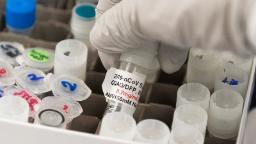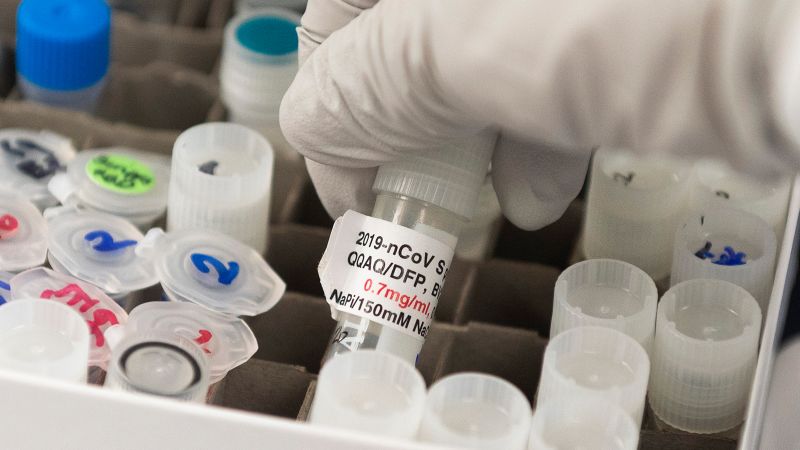
CNN
—
After more than a year with two types of Covid-19 vaccines in use in the United States, another will be up for consideration by the US Food and Drug Administration next week.
The FDA’s vaccine advisers are set to meet Tuesday to consider Novavax’s coronavirus vaccine for the nation.
Based on data included in an agency briefing document posted Friday, an FDA review found that the vaccine’s efficacy was 90.4% overall against mild, moderate or severe Covid-19 for a period of 2½ months after completing the two-dose primary series. The document notes that, in a primary analysis, the vaccine efficacy fell to 78.6% among adults 65 and older.
Those efficacy numbers were collected before the emergence of the Omicron coronavirus variant. It remains unclear how long protection lasts or how well the vaccine will protect against Omicron.
In an announcement published in December, the company reported that the vaccine had “broad cross-reactivity against Omicron and other circulating variants from a primary 2-dose regimen, with responses that increased following a third dose at six months.”
Novavax’s vaccine, called NVX-CoV2373, is given as two doses three weeks apart for the primary vaccination series.
Although most adverse reactions to the vaccine were mild to moderate and lasted just a few days, the FDA did describe rare events of myocarditis and pericarditis – inflammation of the heart muscle and inflammation of tissue surrounding the heart – associated with the vaccine.
“Multiple events of myocarditis/ pericarditis were reported in temporal relationship to NVX-CoV2373 administration, similar to myocarditis following mRNA COVID-19 vaccines and raising concern for a causal relationship to NVX-CoV2373,” the FDA’s briefing document says.
The document describes six cases that happened after vaccination with Novavax. Five were among males ranging in age from 16 to 67. Of the six cases, five were hospitalized but have since recovered.
An increased risk of myocarditis and pericarditis has been identified among people who received the mRNA Pfizer/BioNTech and Moderna Covid-19 vaccines now used in the United States.
In a statement Friday, Novavax addressed the heart inflammation concerns specifically: “We have learned that we can expect to see natural background events of myocarditis in any sufficiently large database, and that young males are at higher risk. Myocarditis is most often caused by nonspecific viral infections.” It said that the rate of myocarditis in vaccinated participants was similar to the placebo group: 0.007% and 0.005%, respectively.
The company added, “we believe there is insufficient evidence to establish a causal relationship. We will continue to monitor all adverse events, including myocarditis and pericarditis.”
The most common adverse reactions to the vaccine were pain at the injection site, fatigue, headache and muscle ache. Reactions were reported more commonly in younger participants in the vaccine’s clinical trials.
In its briefing document, the FDA summarized, “The known benefits among vaccine recipients 18 years of age and older relative to placebo are reduction in the risk of mild to severe COVID-19 occurring at least 7 days after the second primary series vaccination.”
In Tuesday’s meeting, the FDA’s vaccine advisory committee members will vote on the question “Based on the totality of scientific evidence available, do the benefits of the Novavax COVID-19 Vaccine when administered as a 2-dose series outweigh its risks for use in individuals 18 years of age and older?”
In late January, Novavax announced that it had submitted a request for the FDA to authorize its coronavirus vaccine for emergency use in the United States.
In November, Indonesia became the first country to grant emergency use authorization of Novavax’s vaccine. It has since been authorized in the European Union, the United Kingdom, Canada, South Korea, Australia, India, the Philippines and New Zealand, among other countries.
Even though most adults in the United States have been vaccinated against Covid-19, the head of the company has said that it sees Novavax’s vaccine as a potential option for booster doses, regardless of which type of vaccine was given for a person’s initial doses.
Novavax’s vaccine was developed as a protein subunit vaccine, a more traditional type of technology than the mRNA used for the Moderna and Pfizer vaccines. Other examples of subunit vaccines are the hepatitis B and pertussis vaccines.
“We believe our vaccine offers a differentiated option built on a well-understood protein-based vaccine platform that can be an alternative to the portfolio of available vaccines to help fight the Covid-19 pandemic,” Novavax CEO Stanley Erck said in a statement in January.
Novavax’s protein-based coronavirus vaccine relies on something called recombinant nanoparticle technology and Novavax’s adjuvant, called Matrix-M, to stimulate an immune response and high levels of neutralizing antibodies.
Protein-based vaccines like Novavax’s work by getting the body’s immune system to recognize little modified pieces of the virus it’s targeting. In Novavax’s case, that means pieces of the coronavirus spike protein.
When the genetic sequence for the virus that causes Covid-19 was published, scientists around the world quickly identified it as a coronavirus because of the “spike proteins” on its surface. These spikes form large protrusions, giving coronaviruses the appearance of wearing crowns, and “corona” is the Latin word for “crown.”
Novavax scientists identified the gene for the spike protein and created a modified version of that gene. The researchers cloned the genes into a baculovirus that infects insects. They then infected moth cells – specifically, cells from the fall armyworm – prompting them to produce the coronavirus spike protein.
These virus-like nanoparticles were harvested to make Novavax’s vaccine.
“The whole idea of the vaccine is to show the immune system something that looks, tastes and acts like a virus, with the exception that it doesn’t make you sick. So we made the spike protein. We put it in a particle – basically, like a soap bubble – and it’s the size of the virus,” Dr. Gregory Glenn, president of research and development for Novavax, told CNN last year.
“It’s not infectious. We never touch the coronavirus itself,” Glenn added. “Then that is given to people, and they make an immune response that’s very much focused just on the spike – and I would say, the hallmark of our vaccine is, it gives a very strong immune response with very few side effects, and the dose is very small and the vaccine can be stored with normal refrigerated temperatures.”
As Novavax seeks emergency use authorization of its NVX-CoV2373 vaccine, it also is studying a separate vaccine that specifically targets the Omicron variant, called NVX-CoV2515. The company announced this week that it has started a Phase 3 trial of this vaccine, assessing its safety and efficacy as a booster shot.
“The trial will also seek to determine the antibody responses to a bivalent vaccine, containing both NVX-CoV2373 and NVX-CoV2515, administered in participants who have received a booster series of an mRNA vaccine,” Novavax said in a news release.
The trial will analyze the Omicron-specific vaccine and a bivalent vaccine in more than 1,000 participants in Australia.
Two doses of either the Omicron-specific vaccine or the original NVX-CoV2373 vaccine will be given after three doses of either the Pfizer-BioNTech and/or Moderna vaccines that were received at least three months before participants joined the trial.
Similarly, two doses of the Omicron-specific vaccine or the original NVX-CoV2373 will be given after two doses of either mRNA vaccines received at least six months before joining the trial.
Two doses of the bivalent vaccine will be administered in participants vaccinated with three doses of either mRNA vaccine at least three months before joining the trial.
The trial will last about 10 months, and initial results are expected in the second half of this year.

